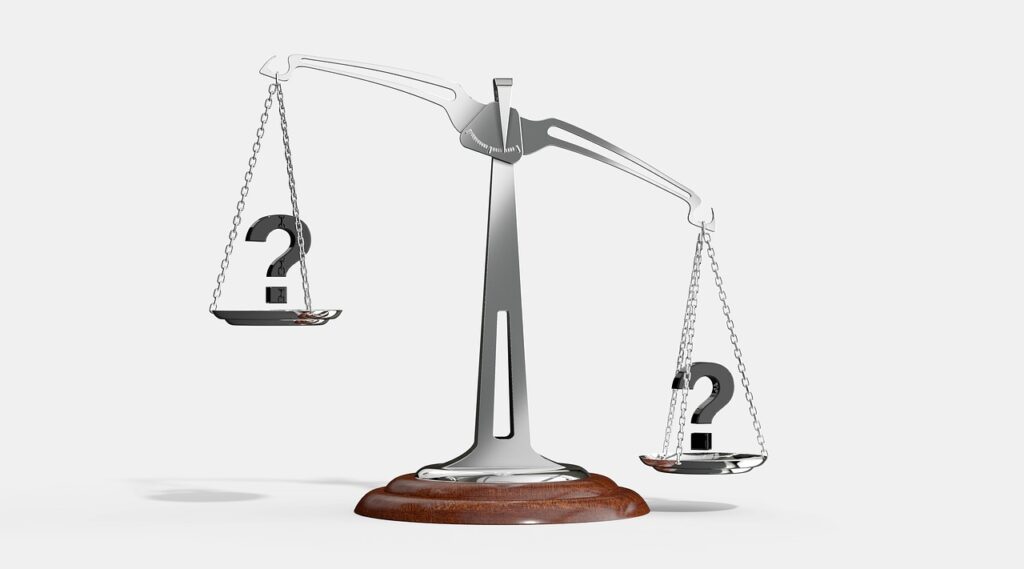
Legislators struggle to keep up with technological and societal advancements, causing organizations to increasingly face choices between ‘right’ and ‘right’. This is why solving a moral dilemma is so challenging. Doing one good thing often means sacrificing another.
Tech giants like Facebook and Google face moral choices such as ‘should everyone be allowed to say anything’ or ‘do we stand for reliable information?’. Across the board, platforms must choose between ‘making money to pay wages and suppliers’ and ‘respecting privacy’. In the following, we present a step-by-step plan to make a choice that you can justify.
Why doing ‘good’ is a dilemma
A (moral or ethical) dilemma is a situation in which one has to choose between two or more equally (un)appealing alternatives. Hence, it’s a decision that can’t be made purely based on logic. The assessment is personal. Examples of moral and ethical dilemmas include:
- Combating fraud versus protecting well-intentioned individuals (as in the childcare benefits scandal)
- Pursuing returns for investors versus safeguarding users (as seen with algorithms on social media)
- Ensuring privacy versus providing user convenience and free access (as in the case of Google)
The initial response to a moral dilemma often comes from an emotional standpoint. You either agree or disagree with a decision. You probably have judgments about the above examples. However, the fact that the assessment is personal doesn’t mean that a moral dilemma can be resolved solely based on personal judgments. Below, we lay out the path for you towards a solution that you can justify to yourself and to others.

Resolving a moral dilemma doesn’t rely solely on ‘instinct’
Although we often instinctively turn to our feelings when facing a moral choice, it doesn’t aid in the solution. To understand why, here’s a brief explanation of how judgment formation occurs. Three moral principles play a role in this process:
- Norms. A norm is a (personal) rule that prescribes behavior for good coexistence
- Values. A value is a principle that we aim to achieve through our behavior
- Virtues. A virtue is a character trait translated into a series of actions aimed at good coexistence
In a well-considered moral judgment, all these principles come into play. In a choice driven by feelings, the strongest or ‘first available’ principle tends to dominate. Yet, even that is often not well thought-out. In the discussion about profit for investors versus protecting users, the image of ‘greedy profiteers’ against unsuspecting users arises quickly. With the norm: ‘fairness in sharing everything’.
While those investors could be pension funds, for instance. They require the profit to provide hard-working individuals with a good retirement who have dedicated years of effort. Therefore, it’s important to formulate a moral question neutrally, as explained further below. The neutral formulation also ensures that all principles are taken into consideration.
Resolving a moral dilemma doesn’t happen on an island
When seeking a solution to a moral dilemma, one is likely to receive advice like ‘do what’s right’, ‘follow your instincts’, or ‘do what feels right’. However, moral dilemmas revolve around determining which right action to take and which one to forgo. What makes it even more challenging is that loaded terms, biases, and the ‘first available principle’ can prevent you from seeing all the ‘good’. As a result, you might make a decision that doesn’t contribute maximally to your values and virtues.
Seeing all the good is already difficult, let alone choosing the right one based solely on feelings.
Own citation
Hardly anyone works alone on an island. Resolving moral dilemmas often takes place within a team, organization, or professional group. They arrive at a shared moral stance regarding the dilemma by exchanging moral arguments. These arguments stem from the aforementioned principles. It’s challenging to engage in a moral conversation or moral dialogue solely based on feelings. Initiating and concluding a moral deliberation is even more difficult. A ‘feeling’ is hard to explain and isn’t easily translated into arguments.
Formulating the moral question (step 1)
The purpose of a moral question is to find good arguments for the answer or response to a moral dilemma. A moral question initiates a process to better substantiate the judgment. It’s not about discovering what is ‘true’, but what is ‘right’. Hence, every moral question includes:
- a neutral formulation of the situation
- who is involved in the dilemma
- why the moral ‘pain’ is caused
The question “Do Apple technicians use Siri to determine users’ interests?” investigates whether something is ‘true’. Therefore, it’s not a good moral question. Similarly, the question “May Apple marketers misuse Siri to eavesdrop on people?” is not a good moral question either. The words ‘misuse’ and ‘eavesdrop’ already suggest that it’s wrong, making the question non-neutral
A good moral question is: “May Apple marketers use Siri to determine interests if users are categorized into specific segments without their knowledge?” This final question (1) is neutrally formulated, (2) indicates who is involved in the dilemma (Apple marketers and Apple users), and (3) specifies the moral concern (namely, users being categorized into segments without their awareness or ability to address it).

Moral Analyses (step 2)
The next step is to compile all the arguments for a judgment. The moral question forms the basis for this, while the moral principles provide structure. In a moral analysis, you list the relevant norms, values, and virtues for each of the individuals involved. Therefore, it’s important to clearly state who is involved in the moral question. By putting all the arguments side by side, an overview emerges. More arguments come forth behind the strongest one. By delving into the arguments of other stakeholders, you see more ‘good’ sides.
For instance, if we want to further examine the moral question “May Apple marketers use Siri to determine interests if users are categorized into specific segments without their knowledge?” it becomes evident that there are two (groups of) stakeholders: the marketers and the Apple users. In the moral analysis, arguments for each stakeholder group and each principle are listed. In a simplified and shortened version, it might look like this:
| Apple Marketers | Apple Users | |
| Norms | I adhere to the law | I have the right to privacy |
| Values | I save users time in searching (helpfulness). | I want to be fully informed (independence). |
| Virtues | I provide relevant results (quality, reliability). | I make conscious choices (self-reliance) |
Formulating a judgment (step 3)
Once all the arguments are listed, it’s time for the judgment. The judgment is the answer to the moral question. It’s a personal consideration. It revolves around which arguments weigh the heaviest for you. And that can indeed be a challenging assessment. Fortunately, there are several ways to break down this process into smaller steps. These steps are:
- What types of responsibilities are at play here (legal, task-related, or only as a virtue)?
- What freedoms are at stake here?
- What rights are involved?
The challenge here is to arrive at a balanced judgment once again. Besides going through the steps mentioned above, the principles of moral leadership also provide guidance to ensure nothing is overlooked. Lastly, involving others in your deliberation can be helpful. This has multiple benefits. Firstly, it helps refine your own thoughts and values. Additionally, aligning your arguments with others in your team, organization, or ecosystem in which you operate is beneficial. Your judgment has a greater impact when others can relate to it.
In all cases, realize that it takes effort to avoid cognitive biases and truly listen during conversations with others. Focus is crucial in this phase. The moral values compass provides insight into how well you apply the principles of moral leadership.

Reflection on the judgment (step 4)
This final step is a self-check. You’ve made your judgment ‘in the present’. However, have you also considered the consequences? And do those consequences align with the values you personally pursue? Take a moment to reflect on the feeling the judgment evokes. If it triggers discomfort, there might be something amiss. Did you truly choose based on the principles that carry the most weight for you? Or have you factored in other interests? The latter doesn’t necessarily have to be problematic, as long as you can justify to yourself why you’ve done so.
Lastly, the question is: will you actually put the judgment into practice? In other words, will you translate the norms and values into virtues?
Nick Nijhuis helps organizations become digitally mature, serves as a business innovation lecturer, conducts training in moral leadership, and is an NIMA examiner


Pingback: Starting and Concluding Moral Deliberation - Moral Leader
Pingback: Building robust, ethical AI systems - Moral Leader